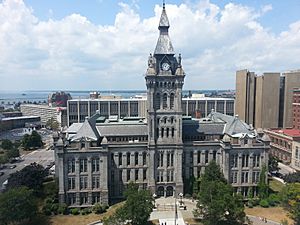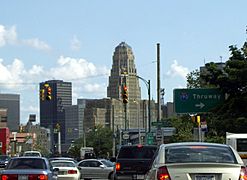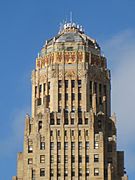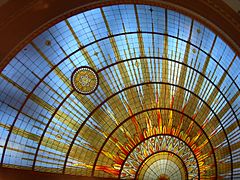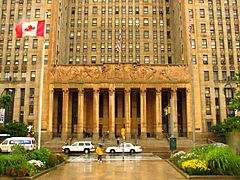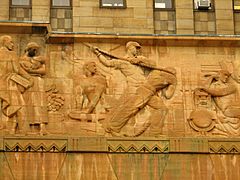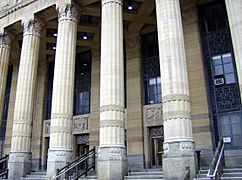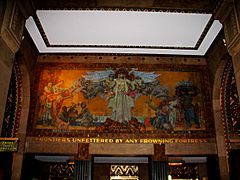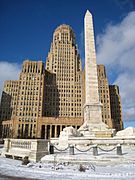Buffalo City Hall facts for kids
Quick facts for kids |
|
|
Buffalo City Hall
|
|
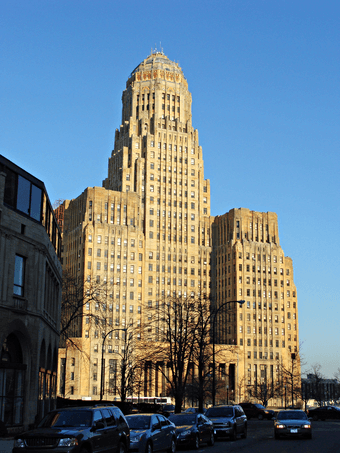
Buffalo's City Hall
|
|
| Location | 65 Niagara Square, Buffalo, NY |
|---|---|
| Area | less than one acre |
| Built | 1932 |
| Architect | Dietel, Wade & Jones |
| Architectural style | Art Deco |
| NRHP reference No. | 98001611 |
| Added to NRHP | January 15, 1999 |
Buffalo City Hall is where the city government of Buffalo, New York works. It's like the main office for the city's leaders and workers. This amazing building is located at 65 Niagara Square.
It's a 32-story building designed in the Art Deco style. It was finished in 1931 by a team called Dietel, Wade & Jones. The building stands about 378 feet tall. This makes it one of the biggest and tallest city government buildings in the United States. It's also one of the tallest buildings in Western New York.
The main architect was John Wade, who worked with George Dietel. Famous sculptors like Albert Stewart and Rene Paul Chambellan created the beautiful carvings on the building. In 1999, Buffalo City Hall was added to the National Register of Historic Places. This means it's a very important historical site.
Contents
History of Buffalo City Hall
Older City Buildings
Back in 1851, the city of Buffalo bought land for its government offices. Between 1871 and 1875, a large granite building was constructed there. This building, designed by Andrew Jackson Warner, had three floors and a tall, seven-story clock tower. It was used by both the City of Buffalo and Erie County.
By 1920, Buffalo had grown a lot. Its population had become four times bigger since the old building was made. So, the city leaders decided they needed a brand new, larger building for the city government. They chose Niagara Square as the perfect spot. This area was part of the city's original plan from 1804. From Niagara Square, you can see Lake Erie and even parts of Ontario in Canada.
Construction on the new City Hall started on September 16, 1929. The building was finished quickly, by November 10, 1931. The official opening happened on July 1, 1932. This was a special day because it also celebrated Buffalo's 100th birthday as a city!
When the new City Hall opened, all the city offices moved there. The old 1875 building then became offices for Erie County courts. It was also used to store important city records. The old building is also a historic place, added to the National Register in 1976.
Building the New City Hall
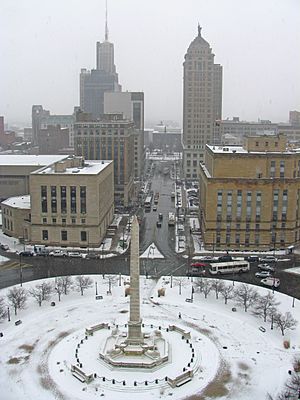
The John W. Cowper Company built Buffalo City Hall. This company also built other important buildings in Buffalo, like the Statler Hotel. Building City Hall cost over $6.8 million. This was a huge amount of money back then, making it one of the most expensive city halls in the country.
Buffalo City Hall was the tallest building in Buffalo for many years. It held this title until 1970, when One Seneca Tower was built. City Hall has 32 floors, but only 26 of them are used for offices. The building has a total floor area of about 566,313 square feet.
There are 1,520 windows from the first to the 25th floor. A cool design feature is that all these windows open inward. This means window washers don't need to hang outside! The building has eight elevators that go up to the 13th floor and four more that go to the 25th floor.
City Hall has a lot of wires and pipes inside. There are about 110 miles of copper wire and 47 miles of conduit pipe! It also has many clocks, about 138 to 143, all controlled by a main clock in the basement. When it was first built, it had 375 telephones and many floodlights to light up the outside at night.
One very interesting part of City Hall's design is its old air-conditioning system. It didn't use electricity! Instead, it used the strong winds from Lake Erie. Large vents on the west side of the building would catch the wind. This wind would then travel down ducts to the basement. The ground would cool the air, which then flowed throughout the building. The winds from the lake were usually strong enough to make this system work well.
In 2006, renovations began on the upper floors of City Hall. The floodlights were replaced. More renovations happened on the south side of the building a few years later. All these updates were finished by 2009.
Gallery
-
Statue of Grover Cleveland, a former Mayor of Buffalo and later a U.S. President.
-
Statue of Millard Fillmore, a former U.S. Representative and President.
-
The William McKinley Monument, near City Hall. President McKinley was assassinated in Buffalo in 1901.
See also
 In Spanish: Ayuntamiento de Búfalo para niños
In Spanish: Ayuntamiento de Búfalo para niños




